Stoye Fahrzeugbau 1925-89
| |
|
|
|
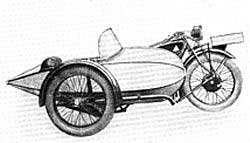
Stoye Sport Seitenwagen 1925
The acquaintance of the mechanic Walter Stoye with the oil representative Hans Mittenzwei in the early 1920s led to the founding of Stoye-Fahrzeugbau-Leipzig. Various sidecars were designed and also adapted directly to the customers' motorcycles, who at that time were mostly sports enthusiasts from the local area.
|
|
|
|
This sidecar was manufactured from around 1925 as the first series model. The chassis was very similar to the later luxury chassis and had a sprung axle and also a sprung body. The body was still made of wood and covered with polished aluminum sheet. A special feature is that accessories such as a chrome-plated racing bar, windshield and electric lighting were offered for an additional charge. A little later, this sidecar was followed by a touring model with a trunk.
This sidecar was delivered to Deutsche Werke Berlin Spandau, among others.
Artur Schüttoff, who met Hans Mittenzwei during a race, also took over the Stoye sidecar for his motorcycles and a little later Hans Mittenzwei and his wife successfully completed many races in the sidecar for the Schüttoff sports department.
It is interesting to note that the early sidecars were connected on both the left and the right side, which was retained until around the mid-1930s.
|
|
Stoye Sport Seitenwagen 1929 |
Stoye Touren Seitenwagen |
|
 |
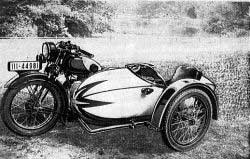 |
From 1929 to 1932, new sidecars were delivered. They were significantly modified; the sidecars were now delivered with different chassis that were adapted to the respective motorcycle.
|
|
Schnellanschlusssystem |
|
|
 |
| |
|
|
The sidecar, protected by several patents such as D.R.P. body and quick connection system, is now already a very sophisticated design.
The bodies are offered with folded aluminum sheet, which was usually hammered but also sanded. Various accessories such as a child seat, all-weather cover and spare wheel holder are a matter of course.
As the production of the sidecars was now considerably simplified and larger quantities could be produced, new supply contracts were repeatedly concluded with many motorcycle manufacturers. The Stoye company began to expand significantly.
|
|
Zündapp - Stoye -
Gespann |
|
|
 |
|
|
|
The Stoye sidecar is also used in sports. Julius von Krohn, who was a racing and test driver for the Zündapp works, drove the Marrakesh - Stockholm route in 1931 with his Zündapp-Stoye sidecar and had no significant losses to his motorcycle or sidecar.
At this time, Hans Mittenzwei switched from the Schüttoff works team to Zündapp and continued to drive successfully at the top with Zündapp - Stoye sidecars.
|
|
Stoye TR-Luxus |
Stoye LR-Luxus |
|

|
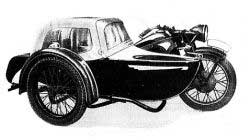
|
|
The year 1933 brought the discerning sidecar enthusiast four different new sidecars, of which the LR and TR Luxus models were the most comfortable and deserved the name Luxus, and not just because of their chassis.
The LR Luxus was advertised as a limousine body. This sidecar had a fabric roll-up roof and could be supplied with various interior fittings, including carpet, on request. The TR Luxus was also supplied with various interior fittings. What goes without saying is that these two luxury sidecars were only supplied with a Luxus chassis.
|
|
Stoye Sport Seitenwagen SS |
Stoye Tourenseitenwagen TS |

|
 |
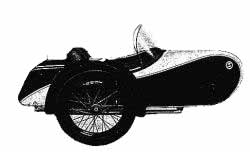
|
|
1933 was also the year in which Stoye's most well-known body shape was introduced, the streamlined body.
Walter Stoye as a designer and Hans Mittenzwei as a racing driver were apparently already aware of the advantages of the streamlined shape. In the following years, this body shape became Stoye's trademark, which was ultimately often copied by other sidecar manufacturers and was retained by Stoye in repeatedly modified forms until 1961.
The SS model was offered with Trumpf, standard and luxury chassis and the TS with standard and luxury chassis.
Stoye-Fahrzeugbau-Leipzig had established itself as a sidecar manufacturer in Germany and throughout Europe at the beginning of the 1930s and sidecars were also exported to France, the Benelux countries and England. From 1935 onwards, the license to manufacture sidecars was granted to the Precision company in France and to CZ in Czechoslovakia.
|
|
Stoye Rennseitenwagen |
|
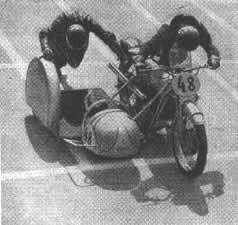
|
|
|
The racing activities of the various motorcycle manufacturers led to the development of the Stoye racing sidecars. These sidecars are exclusively suitable for racing and are specially adapted to the various motorcycles.
|
|
Stoye VS-Leicht |
Stoye Transport-Leicht |
|
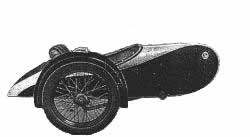 |
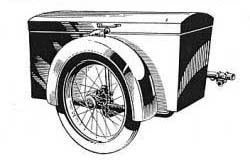
|
|
As two hundred cubic metre machines without a steering wheel or driver became more and more interesting, the Stoye company developed a special, particularly light sidecar for this class of motorcycle - the VS-Leicht. The chassis and the body were a little more delicate than the other Stoye sidecars and the smaller body of the transport sidecar was also offered on the basis of the VS-Leicht chassis.
|
|
Stoye VS-Trumpf |
|
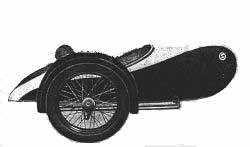 |
|
|
The VS-Trumpf was the cheapest version of a Stoye sports sidecar. This sidecar had the Trumpf connection system and the VS body. It was delivered with a standard chassis and was suitable for light motorcycles up to around three hundred and fifty cubic centimeters.
|
|
Stoye LS-Luxus |
|
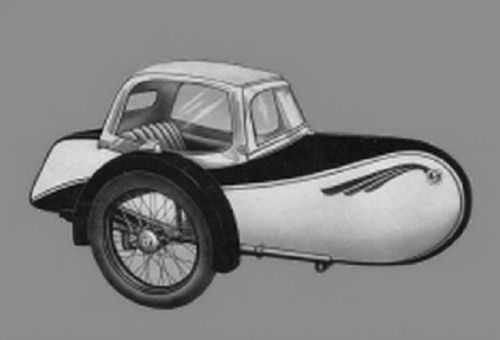 |
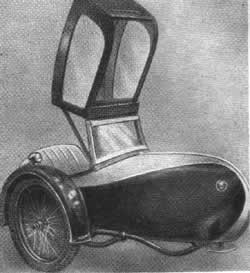
|
After the streamlined body had become popular, Stoye developed another luxury sidecar with a streamlined limousine body, which can be seen as the successor to the LR. This sidecar was later also supplied with a Neimann rubber band-sprung luxury chassis.
|
|
Stoye HS-Luxus |
Stoye HS-Gelände |
|
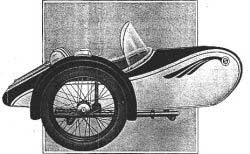
|
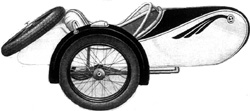
|
|
Another body style was the HS. Although it only had a small trunk behind the seat, the passenger compartment was identical to the body of the TS, for example, and also had two luggage rails for small luggage. The HS was delivered with a standard or luxury chassis.
This sidecar body was offered with a few modifications on the Stoye rubber band sprung off-road chassis.
|
|
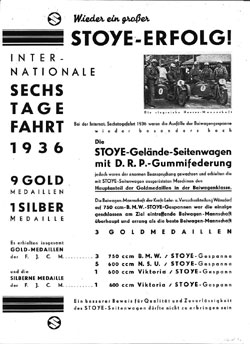 |
|
|
The sidecar team of the Wünsdorf Power, Training and Testing Department drove this off-road sidecar in 1936 on the International Six-Day Race against BMW, NSU and Viktoria Krädern and won nine gold medals and one silver medal.
|
|
Stoye AS-Standard |
Stoye KS-Gelände |
|
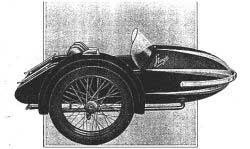 |

|
|
The AS sidecar is another sidecar in the classic Zeppelin shape. It is available with a standard, luxury and even an off-road chassis. Another attempt to expand the model range was the KS sidecar. This sidecar was offered with and without a trunk, with a luxury and an off-road chassis.
It is designed for heavy motorcycles as a variant of a sporty sidecar that proves its worth on normal roads, but also in difficult terrain. What is interesting about this sidecar is that it is very similar to the later military sidecar.
|
|
Lieferseitenwagen
|
|
 |

|
|
Motorcycles were also of interest to businesses for transporting all kinds of materials. Stoye therefore also supplied delivery sidecars with standard and luxury chassis. One of the major buyers of these sidecars was the Reichspost, which had a not insignificant number of these sidecars in operation.
|
|
Stoye Anhänger |
Fahrgestell für Stoye Anhänger - Chassis for Stoye trailer |
|
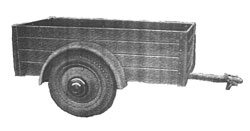 |
 |
The ball connection was further developed as a connection system for car trailers. Trailers were also offered to complement the model range.
|
|
Stoye Heeresseitenwagen |
|
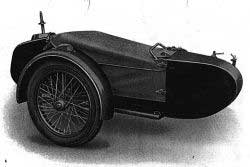 |
|
|
Since Walter Stoye and Hans Mittenzwei also worked for the Army's Power Training and Research Institute, an army sidecar was developed based on their experience in racing and off-road sports. Ultimately, only a small number of these were delivered, although they served as a model for the well-known army sidecars.
Stoye also developed other sidecars and equipment for the Wehrmacht. These include the torsion bar sidecars for Zündapp, the powered sidecars for Zündapp KS-750 and BMW R-75, the ammunition trailer including trailer coupling for these motorcycles, or the trailer coupling and trailer for the half-ton tractor NSU- Kettenkrad.
The Second World War began in 1939 and these Stoye developments were used on all fronts until 1945. Due to the great demand for sidecars at the front, many Stoye sidecars that were actually manufactured for civilian purposes were also repurposed by the Wehrmacht.
|
|
Stoye SM-Standard |
|
|
 |
|
|
Nach
dem zweiten Weltkrieg, teilten die Alliierten Siegermächte Deutschland unter
sich auf.
After the Second World War, the victorious Allied powers divided Germany among themselves.
Stoye-Fahrzeugbau-Leipzig was now in the Russian occupation zone and began producing new sidecars in 1949. The Stoye SM was the first sidecar to be produced in the post-war period and was initially delivered to SAG-AWTOWELO.
|
|
Stoye SM |
Stoye UR |
|
 |

|
|
The newly founded German Post Office in the Russian-occupied zone needed transport sidecars in 1952. The Stoye UR is now supplied to the German Post Office in conjunction with AWO 425 motorcycles from AWTOWELO.
|
|
Stoye - Geländeseitenwagen |
|
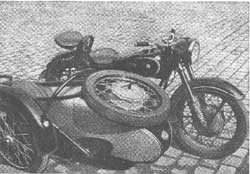 |
|
|
Stoye also started manufacturing special sidecars for off-road sports and began developing various sports sidecars for the motorcycles in the zone.
|
|
Stoye TM |
|
 |
|
|
Around 1954, a new touring model with a more spacious passenger compartment and a trunk was offered. Although this sidecar still had the classic streamlined shape, it was a completely new development.
|
|
Stoye TS |
|
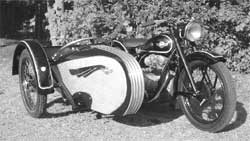 |
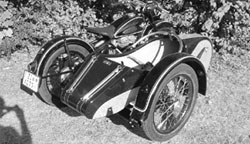 |
|
In addition to the Stoye touring sidecar, a sports model was also offered from 1956. This sidecar was the same as the touring model, but like the Stoye SM, it only had a small trunk behind the seat.
|
|
Stoye EL |
|
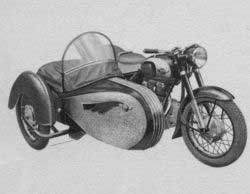 |
|
|
In 1958, the Stoye-Elastik came onto the market. In the Eastern zone, it was offered for the AWO 425 Sport and MZ-ES 300 motorcycles.
This sidecar was a complete innovation in sidecar construction; it was specially designed for motorcycles with rear swing arms. This was understandable, as almost all manufacturers began to use rear swing arms in their motorcycles and Stoye had always been very progressive.
The absolute innovation of this sidecar was that the rear swing arm of the motorcycle was coupled to the swing arm of the sidecar.
|
|
Stoye SEL |
Stoye LSW |
|
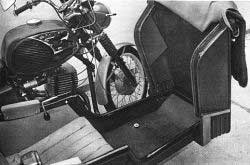 |
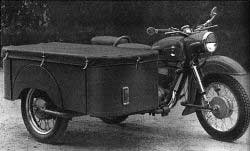 |
|
After the Stoye Elastik had become popular, the Stoye Super-Elastik was designed. This sidecar no longer had the classic streamlined body.
It could be opened up at the front for easier entry, had an oil-damped shock absorber, a hydraulic brake system and the connection from the rear swing arm to the sidecar swing arm was created via a torsion bar.
The Stoye SEL was again delivered in two different versions. One for Simson and the other for MZ. The Stoye LSW was also offered as a cargo sidecar.
When motorcycles were no longer manufactured in Suhl in 1961, the last motorcycle manufacturer left was the Zschopau motorcycle factory in the still Russian occupied zone. Bad times began for Walter Stoye and Hans Mittenzwei.
In 1961, Stoye-Fahrzeugbau-Leipzig was partially nationalized and MZ set the tone. From now on, the SEL was only adjusted to the latest MZ model up to ETZ 251 until 1989.
|
|
IWL-Campi |
|
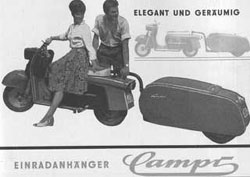 |
|
|
Stoye also continued to manufacture trailers for cars and, after the IFA-Werk-Ludwigsfelde began manufacturing city scooters, trailers for these scooters.
The Campi was a single-wheel trailer that, as part of the model upgrades for the Pitti, Wiesel, Berlin and Troll city scooters, was given new bodies that were made to match the various scooters.
In 1972, many companies that had been in private or partially nationalized hands until then were expropriated, including Stoye.
Hans Mittenzwei, who had still been managing director of Stoye - Fahrzeugbau up to this point, was compensated with sixty thousand East German marks and dismissed as managing director. From then on, Stoye - Fahrzeugbau was called MZ-WERK four.
|
|
Stoye SEL 1989
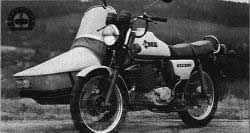
|


